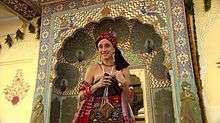Production of Caminho das Índias
Caminho das Índias artistic and general director, Marcos Schechtman, and director Fred Mayrink traveled to India to write the telenovela's first scenes, which started to be filmed on October 1, 2008, in the cities of Jaipur, known for its pink walls, and Agra, famous for Taj Mahal. In addition to 40 people from the Brazilian team, the telenovela had the partnership of a local producer.
The modern architecture of Dubai, in the United Arab Emirates, also served as filming locations for the show at the end of October.
Setting

In order to recreate the environment where the story of Caminho das Índias evolves, three scenographic cities were built at the Globo TV Studios Complex in Rio de Janeiro, totalling impressive 11,500m2 of area.

One of them imitates the typical architecture of Lapa neighborhood in Rio, while the other two attempt to recreate some features of the Indian state of Rajasthan.
Using the cities of Jaipur, Jodhpur and Mumbai as references, the art director built 42 shops and a complete temple in honor of the Hindu god Shiva, in addition to the façades and entries of a movie theater and the terracota-colored households of the four main Indian families of the story. One of the margins of the Ganges was also reproduced, through an artificial lake built near the entrance of Globo TV Studios Complex.
Objects and costumes

The art production team, led by art director Mario Monteiro, attempted to reproduce a true Indian universe on camera. The Indian core of the telenovela received a very colorful ambiance, which opposes to the clean aesthetics of the Brazilian scenarios.

Several typical Indian objects were purchased, samples of the characteristic transportation means were built by the team in order to circulate around the scenographic cities and there are inscriptions in Hindi all over the sceneries.
The clothing was also carefully studied by figurinist Emilia Duncan. Women's traditional clothes, such as the Sari were recreated, although with a bit of poetic license, thus bringing some clothing usually used in rituals for the everyday wearing.
See also
References
- Bastidores (in Portuguese), Rede Globo, retrieved 2009-01-22